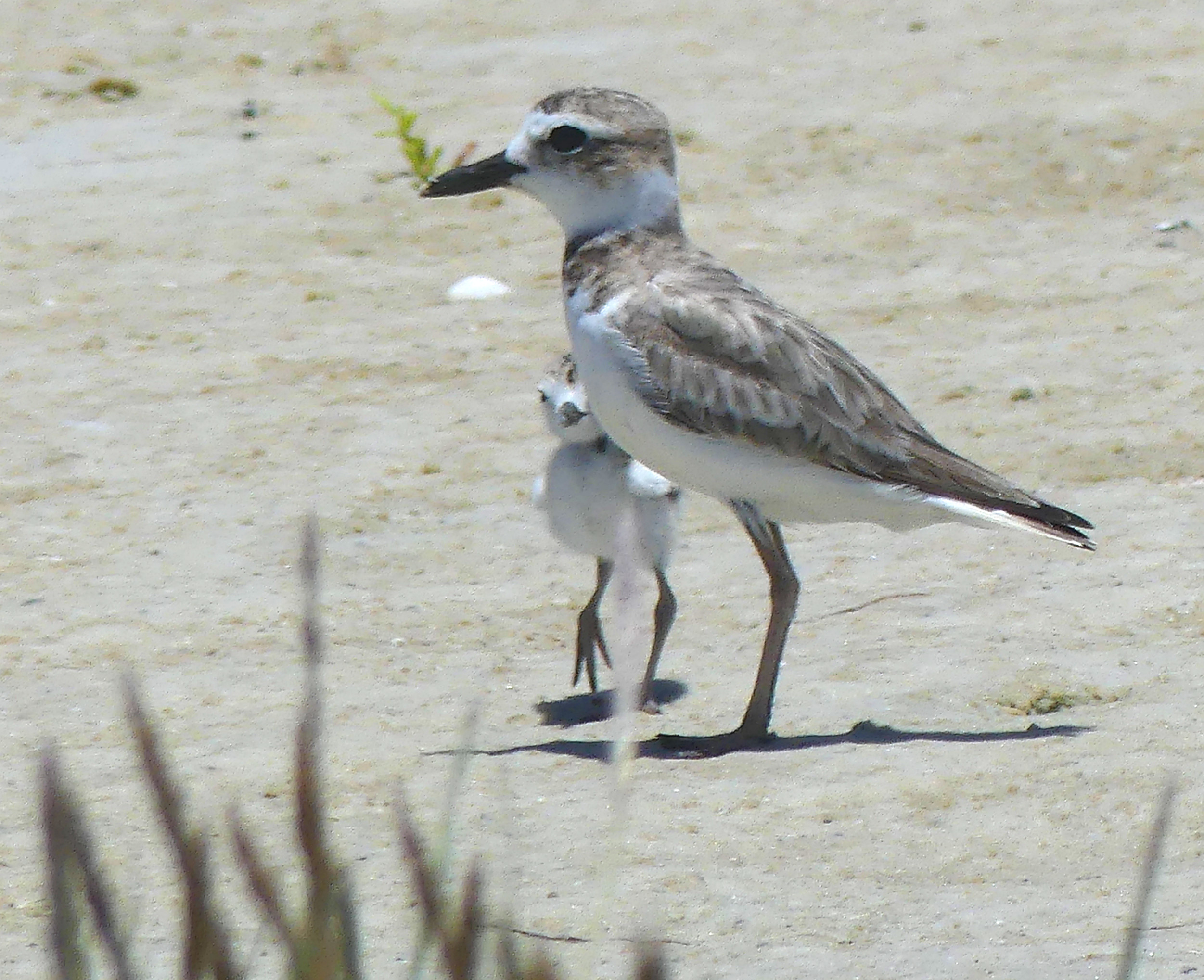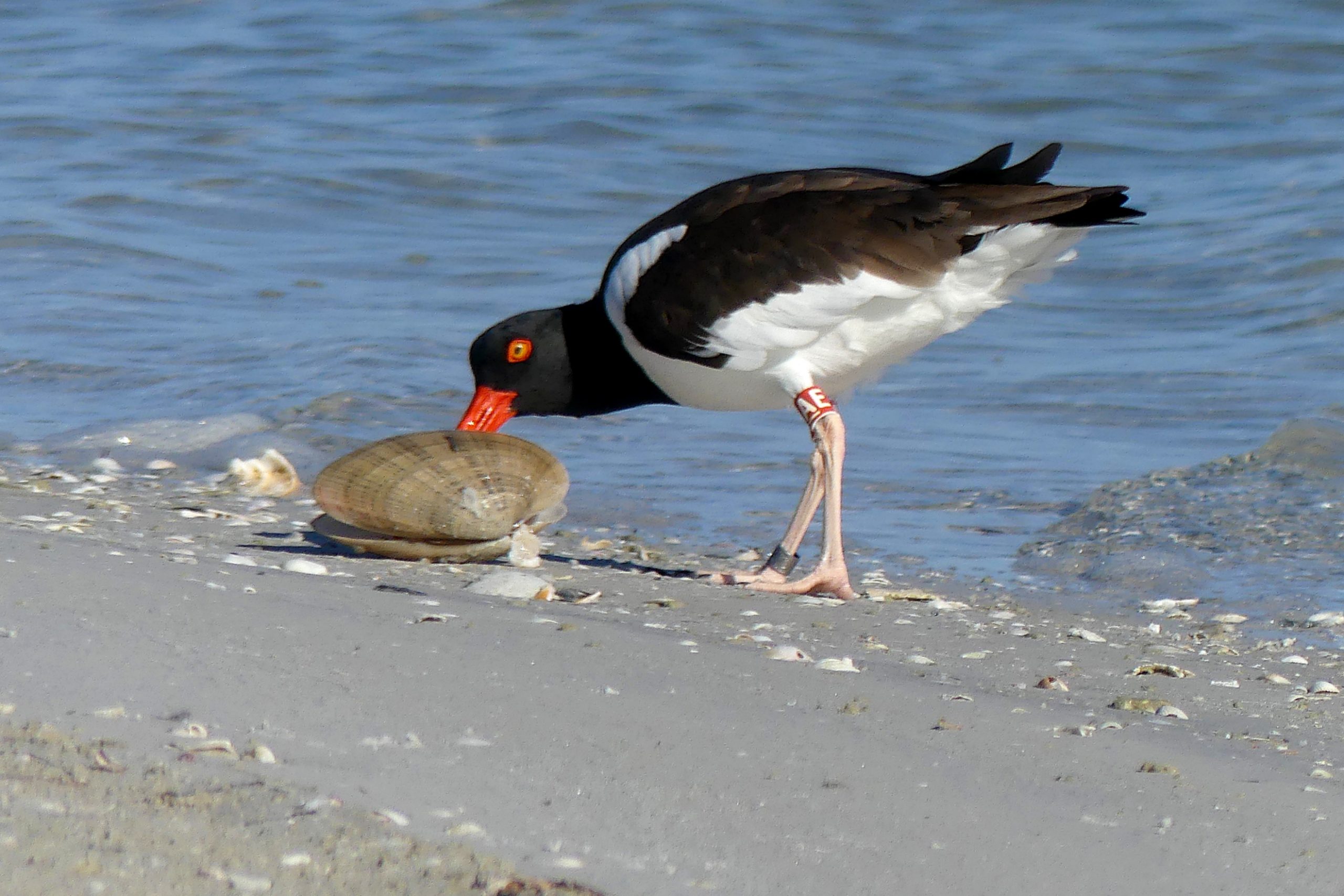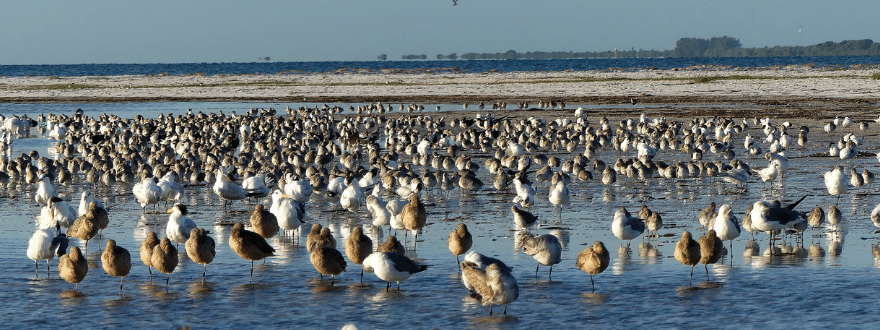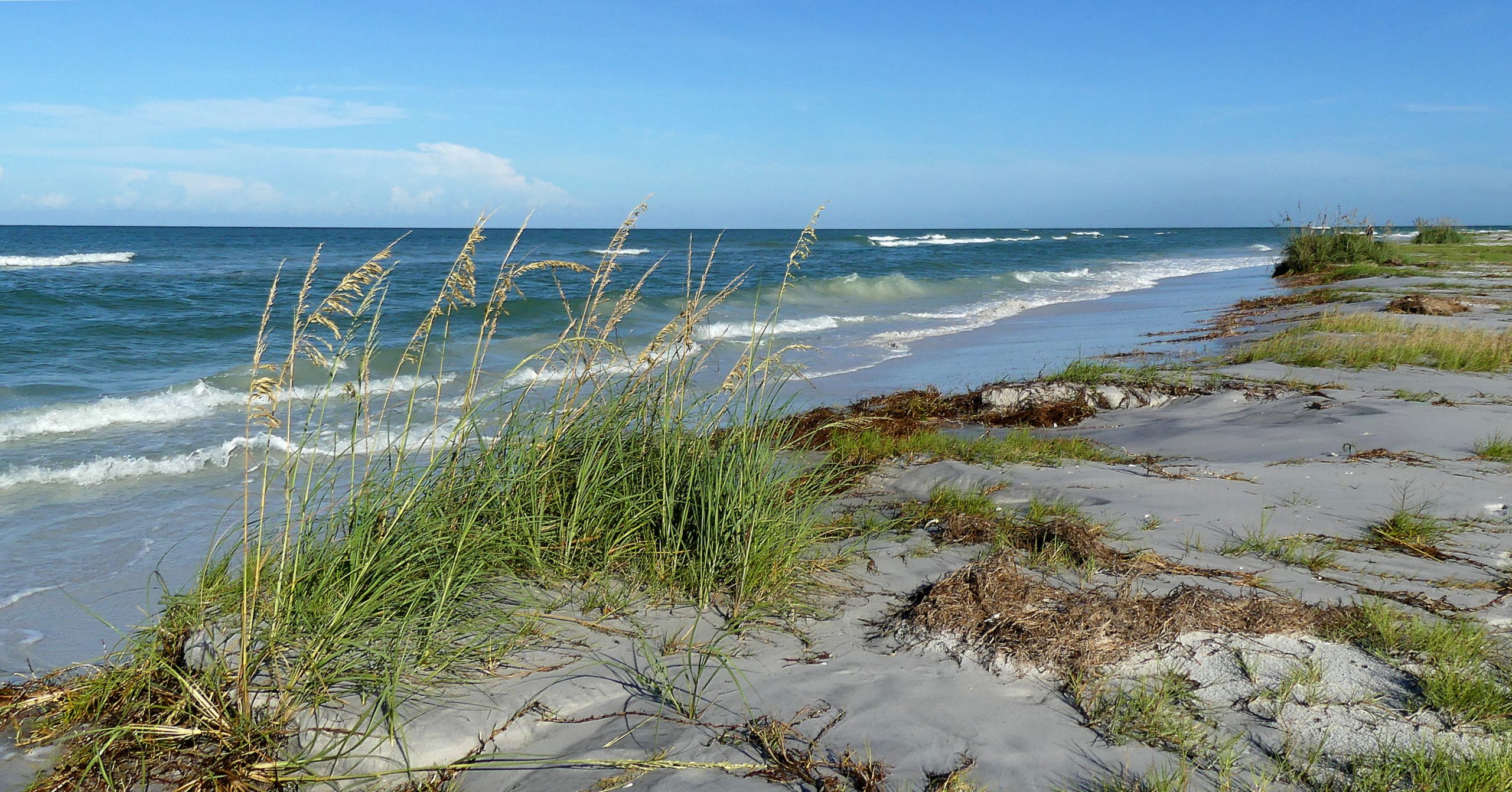
Walk with me. It’s almost dawn. You park at the far end of the Fort De Soto Park north beach parking lot. Make sure you have your water shoes on and prepare to get your pants wet. Cross a short channel of water, about 25 feet wide, and you’ve come to the magical Outback Key.
Guest column and photos by Lorraine Margeson; Published September 2020
Even before you can see them, you can hear hundreds if not thousands of seabirds and shorebirds, depending on the time of year. And then you do see them as you walk north. There are black skimmers, roseate spoonbills, least terns, snowy plovers, marbled godwits, royal terns, brown pelicans, American oystercatchers, red knots, reddish egrets, savannah sparrows, peregrine falcons, common ground doves, least sandpipers and lesser black-backed gulls. What you see depends on the time of year, but you’ll always see cool birds any time of the year.
And then there are the plants. Lovely dune systems topped by sea oats surrounded by sea rocket, seaside purslane, marsh elder, beach evening primrose, inkberry and if you look really hard you’ll see Spanish bayonet amongst the flora making a home on the key. Even red and black mangroves are starting to take root first time this summer.
And if you haven’t seen enough to make it worth the trip already, there are the horseshoe crabs spawning, loggerhead sea turtle nests, male sea horses carrying the eggs of their young, and manatees and dolphins cruising the Outback Key lagoon. Well, I think you have the picture. As a photographer couple new to the key told me recently, “We’ve died and gone to heaven.”
Outback Key itself comes and goes periodically according to Pinellas County photos going back to the early 1900s. The last time Outback Key looked like this was in the 1970s; and the current iteration began in about 2013. Dr. Ping Wang at the University of South Florida has been studying Outback Key for years and believes that there is a 25-year cycle in which it develops and attaches to Fort De Soto then fades away again.
Most of the key is in the Pinellas County Aquatic Preserves but it’s managed by the Florida Department of Environmental Protection as submerged land rather than a critical natural resource – so it has become a party spot that attracts hundreds of boaters every weekend. At this point, there are no rules on Outback, so boaters and their dogs are free to wreak havoc with no protection except for areas that have been posted for birds or sea turtle nests.
The Florida Fish and Wildlife Conservation Commission (FWC), under the direction of District Commander Major Roger Young, was instrumental in protecting nesting birds this summer, putting law enforcement boots on the ground to protect them during busy holiday weekends and supporting volunteers on the island.
Pinellas County has asked for this land to be deeded to the county but FDEP has refused so far. The county also is pursuing the option of managing it without ownership, following the example of Shell Key which is owned by the state but managed by the county.

Even so, significant shorebird nesting has occurred with volunteer management by Dr. Beth Forys of Eckerd College in 2015, the first year that nesting occurred, and myself since 2016. The FWC Beach-nesting Bird Plan focuses on five beach-nesting species: American oystercatcher, snowy plover, Wilson’s plover, least tern, and black skimmer.
All five of these species have successfully fledged young on Outback Key, which is an awesome accomplishment for a beach in the state’s most densely populated county. While these species cross taxonomic groups, they overlap significantly in specific locations, habitat requirements, current threats, and conservation needs.
“Outback Key plays a vital role for both nesting and migratory waterbirds,” says Forys, a nationally renowned expert in black skimmers and least terns. “There are very few natural islands left in our region and Outback Key provides both nesting habitat and excellent foraging for seabirds like least terns and black skimmers, as well as nesting shorebirds like American oystercatchers, snowy plovers and Wilson’s plovers.
“In fact, least tern chicks on Outback Key this past summer appeared to grow faster and fly sooner than least terns in less pristine habitats,” she continued. “Productivity of plover species was higher than areas nearby. If we could decrease the number of dogs and other major human-influenced disturbances, this island could produce and fledge even more chicks.”

And that’s before you start counting the migrating and wintering birds that use Outback Key for feeding and resting. How many 65-acre preserves in Florida regularly host upwards of 50 federally endangered piping plovers (many of them banded and which have returned every year since 2016), 500 or so federally endangered red knots (many returning year after year also based on banding data), 15 to 20 state-threatened snowy plovers and 40 or so state-threatened Wilson’s plovers — not to mention the resident American oystercatchers? I bet you can’t name one.
Or how many keys do you know in this size range that reliably host 800 to 1,000 wintering American white pelicans when they come in at the end of October? Or peregrine falcons, 30 to 40 savannah sparrows, peregrine falcons, 600 to 800 black-bellied plovers, 50 to 75 marbled godwits, and on and on.
For avid birders, some rarities seen on the key include Wilson’s phalaropes, American avocets, buff-breasted sandpipers, pectoral sandpipers, American pipit and black-throated green warblers.
This is why you can never strike out on something cool to see when you visit Outback Key, it’s an ever-changing feast for the eyes.
I’ll conclude with this thought: Outback Key is an incredible gift to wildlife in the most densely populated county in the state, an undeveloped island that almost magically appeared at a time when birds are increasingly threatened by habitat loss. This amazing place is in sore need of protection, whether it’s managed by the county on behalf of the state or FDEP deeds it over as accreted land to Fort De Soto Park.
Lorraine Margeson is a long-time volunteer with the Florida Shorebird Alliance and is certified as a bird monitor by the U.S. Army Corps of Engineers and the FWC. Since 2014, she has worked on multiple construction projects across the state for the corps and county governments through various environmental firms. She has been recognized for her volunteer activities by the city of St. Petersburg, the Southwest Florida Water Management District and the Florida Native Plant Society. Please contact editor@baysoundings.com if you’d like to support her efforts in protecting Outback Key.

